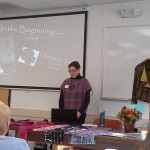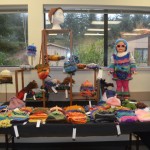The tip jar raddled and here are your favorite tips from November –
Showcase is a great way for others to get new ideas, new approaches and great ideas. Each month, please bring what you are working on or have completed and share what you learned in the process of creating.
Nancy Sedlacek’s prayer flags were woven using 10 of the various treadling variations from the “Rose Path Project No. 1” pattern, either threading 3 or 4, from A Handweaver’s Pattern Book by Marguerite Porter Davison. It was like doing a twill sampler, only making individual flags from each variation. Great fun!
Learn more about Tamarie balls see http://www.temari.com/. Nancy Sedlacek used felt balls as her base for the Tamarie balls she made.
Men’s ties are great for embellishments to your hand woven or felt projects.
http://www.leclerclooms.com/book/warp&weave.htm This free book to download has instruction on warping and weaving different types of looms. Do not miss chapter 11 “What Every Weaver Should Know”
For tapestry see http://www.leclerclooms.com/book/Iweave_v2A.pdf
Terri Whitehouse shared how to Twist and Knot and was a great help to the person sitting next to her. Sharing those little tips with each other helps us all. Yarn Barn one of our advertisers describes the fringe twister and how to use http://www.yarnbarn-ks.com/Fringe-Twister/productinfo/WA-XX-FRT-/
Scan your yard, your neighbors yard, the church yard or the field down the way to see what is available and use nature to dye hand spun wool.
Members taking time to go though their history provided excellent background information showing progression in design and complexity of there work. Building on what your know, what mentors share, influence from other disciplines, especially art, reading and exploring with classes are all ways possible to progress on your journey. Planning is an important part of the journey too. Nancy Sedlacek went back and discovered how early on in 4-H she developed her process Plan To Learn. Read on for Nancy’s discovery.
Wow – it was definitely serendipity this weekend! Went to visit my parents and my mother had set our some old cook booklets – one of which was one of my 4-H books! So now I can look at the actual book and I really see how I began to form my method of learning a new skill on my own.
To begin, one must of course choose the topic. In the case of this booklet, it was how to bake. The booklet then sets up a plan for making increasingly complicated items. This plan is up front as one has to complete a certain number of items to achieve the level or learning. The list looks at pretty much all aspects of the topic – one must not only bake several different types of goods, but must bake several within each type, must judge other baked goods and compare commercial to homemade. One also has to demonstrate to others how to do the baking, has to serve their baked goods to others and submit some to judging and, finally, one must also visit a professional bakery. Along with the baking and activity list,, there is also a list of other skills that need to be used and/or learned in order to do this project. (And this is all just in the first page!)
Then the book goes over background information for baking, and gives written directions for how to do different techniques. It also instructs in how to plan to bake. Then there are recipes, a glossary, more instructions and background with every type of baked good covered, and ideas on how to incorporate baked goods into a day’s healthy menu, plus how to serve the items. The back cover is a record sheet for recording all that one did in the project.
As you can tell, this is all pretty thorough for a 10 to 12 year old’s exploration and learning of a new skill! And the entire program was done this way, from all the cooking skills to fiber arts and animals. What is interesting to me as I look this over is that this is very similar to how I designed my foods classes for the high schoolers I taught!
As an adult I do a similar process –
I identify what I want to learn, then I make a plan for what the various steps are in my learning process for the particular skill. I spend a lot of time gathering all the written background and information I can about the skill or subject, taking notes along the way as I read. (I don’t watch videos and seldom take classes as I learn best by reading – which I realize is not for most people!) Once I feel I have enough information, I begin to try techniques to learn how to do them, using the books and illustrations I found. As I gain skill, I make a plan or timeline for creating items or producing things that will challenge me to perfect the skill or technique. I try to work my way to a “final project” that will incorporate all I’ve learned and (hopefully!) show mastery of the skill/technique.




